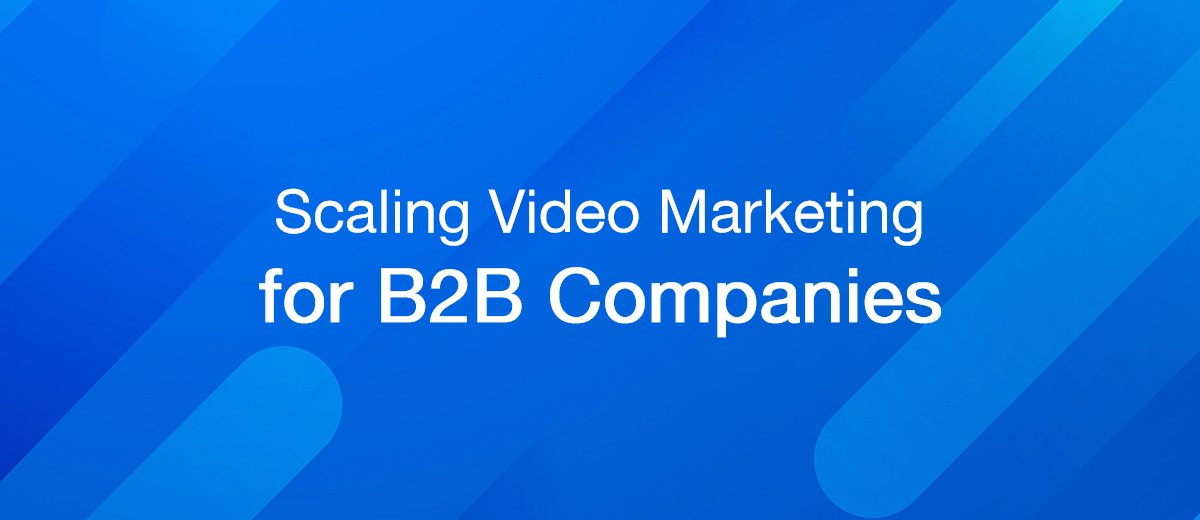Scaling Video Marketing for B2B Companies: Best Practices
Video marketing has become increasingly popular recently and is now one of the most effective ways to reach potential customers. This is especially true for B2B companies, who have seen a massive increase in their ROI when using video content. According to Forbes, businesses that use video as part of their marketing strategy are growing revenue 49% faster than those without. However, scaling video marketing for B2B can differ slightly from other companies because it requires more strategic planning and execution. In this blog post, we'll discuss best practices for how to scale your video marketing specifically for B2B companies, so you can maximize your ROI and see real results from your efforts.
Understand Your Audience
When scaling video marketing for B2B companies, the first and most crucial step is understanding your audience. After all, video marketing aims to capture potential buyers' attention and persuade them to act. And to do that effectively, you need to know exactly who you're trying to reach.
Consider the industry and niche your B2B company operates in. What are the pain points and challenges that your audience faces? What are their goals and objectives? What motivates them to make purchasing decisions? By answering these questions, you can better understand how to craft your video marketing strategy and tailor your content to appeal to your target audience.

For example, let's say you run a B2B software company specializing in small business project management tools. Your audience might include entrepreneurs, small business owners, and project managers looking for software solutions to help streamline their operations, such as through B2B factoring.
Another way to understand your audience is to pay attention to their behavior online. Use data analytics tools to track engagement rates, click-through rates, and watch time on your videos. By analyzing this data, you can see which videos resonate with your audience and which don't. You can then use this information to adjust your video marketing strategy and create more content your audience will find helpful and engaging, all the while putting more money into your savings account.
Leverage Existing Content
As a B2B company, you may have already produced a lot of content, be it blog posts, eBooks, or white papers. By leveraging your existing content, you can save time and effort on video creation while also making the best use of your existing resources.
One way to do this is by repurposing your existing content into video format. For example, you can turn your blog posts into short explainer videos or create a webinar from your white paper. This way, you can reach a wider audience with the same content while also giving your audience new ways to engage with your brand.
Repurposing content also allows you to take advantage of the SEO benefits of video. By embedding videos on your website or sharing them on social media, you can increase your online presence and drive more traffic to your site.
Another way to leverage your existing content is by creating a video series. For example, if you have a series of blog posts on a particular topic, you can turn them into a video series that provides more in-depth insights and information. This saves time on content creation and establishes your brand as a thought leader in your industry.
Utilize Social Media Platforms
As we all know, social media has completely transformed how businesses interact with customers. It's no surprise, then, that social media platforms play a vital role in the success of a company's video marketing strategies.
For B2B companies, social media platforms like LinkedIn and Twitter provide an excellent opportunity to connect with industry professionals, grow brand awareness and reach, and ultimately, boost sales. In addition, incorporating well-crafted videos in your social media presence will yield a higher engagement rate, as videos resonate better with viewers and keep them engaged.
Let's take LinkedIn, for example. With over 700 million active users, LinkedIn offers a massive audience actively searching for content that aligns with their interests and goals. According to Social Media Examiner, native LinkedIn posts with videos have almost five times more engagement than those without. This staggering statistic underlines the importance of leveraging social media platforms for scaling video marketing.
Another example is Twitter. While the platform may have started as text-based, it has since evolved to support multimedia content like videos. For instance, Twitter video advertising, in which businesses can run short ads showcasing or even launching their product, has proven highly effective in reaching and converting new customers.
Track and Measure Performance Metrics
Tracking and measuring performance statistics is crucial when scaling the success of video marketing for B2B companies. Without keeping tabs on the performance of your videos, it's impossible to understand what's working and what's not. By measuring key performance indicators (KPIs) such as engagement rates, view counts, and click-through rates, you can analyze what's resonating with your target audience and make data-driven decisions to optimize future video content.

For example, let's say you're a B2B tech company that specializes in software solutions for small businesses. You create a video highlighting the benefits of your latest product, and you want to see how it performs on social media. After monitoring your KPIs, you notice that the video has a high view count but a relatively low engagement rate. This indicates that while people are watching the video, they are not taking the time to interact with it or take further action.
Armed with this information, you can tweak the video to include stronger calls to action, more engaging visuals, or clearer messaging. By making informed decisions based on performance data, you can ensure that your video content is constantly improving and resonating with your target audience.
Another example could be a B2B manufacturing company that wants to scale its video marketing efforts. They begin by creating a series of product demo videos to showcase the features and benefits of their machinery. Then, by tracking engagement and conversion rates, they notice that one particular video in the series consistently outperforms the others. This could indicate that the video is extremely helpful for potential customers who are trying to make a purchasing decision.
Wrap Up
Video content is a potent marketing tool, but it's important to remember that best practices for scaling video marketing can differ drastically between B2B and other types of companies. By understanding the unique challenges B2B companies face when creating and distributing video content, they can ensure their efforts are successful and cost-effective.
Time is the most valuable resource in today's business realities. By eliminating the routine from work processes, you will get more opportunities to implement the most daring plans and ideas. Choose – you can continue to waste time, money and nerves on inefficient solutions, or you can use ApiX-Drive, automating work processes and achieving results with minimal investment of money, effort and human resources.

